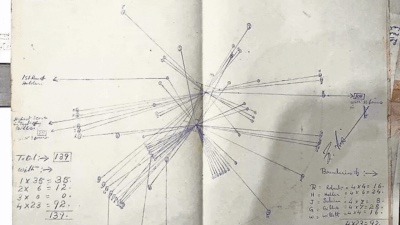Arvind Gutgutia
This is a collection of articles archived for the excellence of their content. |
A brief biography
Arvind Chauhan & Fazal Khan, TIMES NEWS NETWORK, Oct 23, 2023: The Times of India

From: Arvind Chauhan & Fazal Khan, Oct 23, 2023: The Times of India
Lucknow/Barabanki : These days, they do it in laptops, with user-friendly software that asks for little more than moving the cursor here and there — but back in the day of cricket before computers, plotting a batter’s innings was an artform.
A wagon wheel — the graphical representation of a batter’s innings, showing the distribution of shots — then required sharp eyes, steady hands, and some artistic flair, aside from, of course, cricketing knowledge. Drawing the wheel by listening to radio commentary, in pre-TV days, or watching the match from the stands wasn’t everyone’s cup of tea. But at least most ‘wheel-makers’ were professional employed by the game.
Arvind Gutgutia was an amateur, driven by his love for the sport, and natural talent. His wealthy family was in coal and flour milling businesses. But in 1970s Calcutta— as Kolkata was known then — Gutgutia, in his 20s, was in the business of plotting the progress of some of cricket’s finest batters. Among them, Sunil Gavaskar, who was rewriting record books after his famous 1971 debut in the West Indies.
Gutgutia now lives in Barabanki, UP, where decades back he was sent by his father to run a flour mill. Gavaskar, who was recently in Lucknow as part of the cricket world cup commentary team, was charmed when told that a 70-something UP resident had, almost five decades back, wagon wheeled some of the batter’s best performances.
“I consider myself a librarian of memories. I have antique watches, old gramophones and radios, ancient coins and decades-old newspapers and documents,” says Gutgutia. But his most loving possessions are his wagon wheels. “Ï should have been born in a cricketer’s home,” Gutgutia, born in a business family, tells TOI.
“Each of wagon wheel has a tale associated with it…I share those stories with my family, friends and neighbours. Cricket is very close to my heart,” he says.
Gutgutia’s love affair with cricket started in his teens. He was trying his hand at wagon wheels when he was 17. “I wanted to understand how bat ters played pace and spin…how they changed shots,” he says. He followed Calcutta’s cricket league, saying it was a tough, demanding league. He even played in the second division. But his forte was plotting, not playing. And the radio gave his source material. He says top class commentary by Indian and foreign commentators, who were clear in their description and so witty they kept the listener engaged, helped him represent an innings accurately on paper.
He drew hundreds of wheels between 1969 and 1978 in Calcutta. But then got mar ried and moved to Barabanki and moved into business. Among his wheels are the ones plotting Gavaskar’s century at Old Trafford, England in 1974. How did that innings go? Gutgutia has all the info – “251 balls, eight boundaries, 20 singles, 11 twos and 9 threes,” he gives a break-up. He had plotted Salim Durani, Gundappa Viswanath, Anshuman Gaekwad, Vivian Richards, Gordon Greenidge, Clive Lloyd, Bernard Julien, Alvin Kallicharran and many other batters.
“In 1972-73, during India vs England match at Calcutta, Salim Durani scored 53 runs off 139 balls in the second innings…I cannot forget Durani’s six over square leg, hit on spectator demand.”
There’s more to this story. “In the evening, when I met Durani in the hotel, his first question was, ‘where is that square leg six in the wagon wheel’, and I promptly pointed my finger on the chart to show him. He was generous enough to sign on my wagon wheel,” Gutgutia happily recalls.
Now 71, he’s waiting and hoping Sunil Gavaskar will sign one of his Gavaskar wagon wheels.